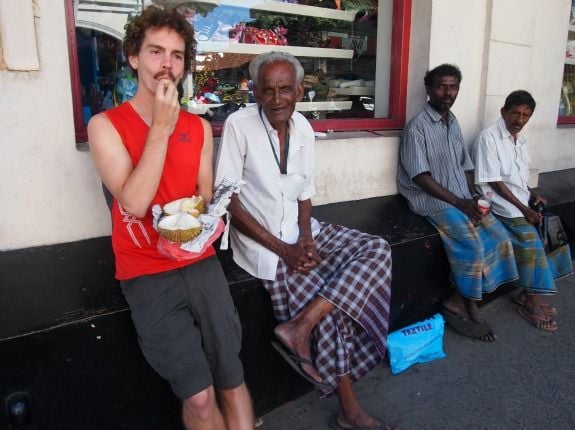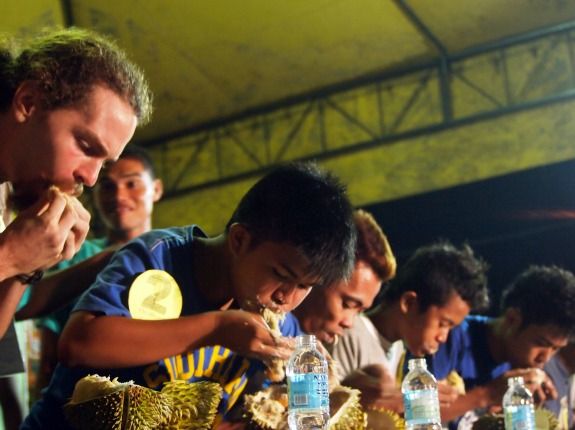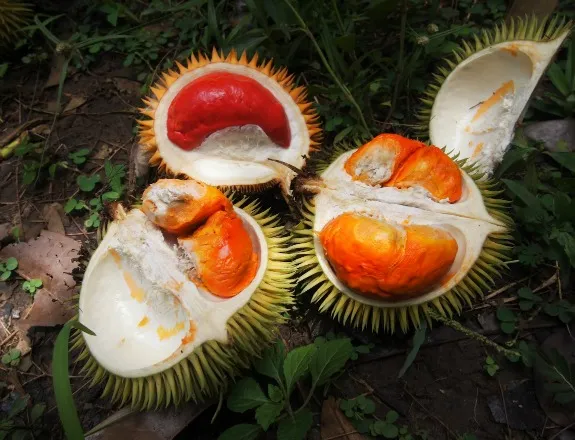Faces From Afar: Two Oregonians on the Hunt for Exotic Durians
Meet Lindsay Gasik and Rob Culclasure, who are spending a year of their lives in Southeast Asia feasting on the bizarre fruit
/https://tf-cmsv2-smithsonianmag-media.s3.amazonaws.com/filer/20121102091140DurianRobAndLindsaySMALL.jpg)
This is the first in the series “Faces From Afar” in which Off the Road profiles adventurous travelers exploring unique places or pursuing exotic passions. Know a globetrotter we should hear about? E-mail us at [email protected].
Before leaving home, many travelers research ahead on key points of their destination. They investigate whether a nation is safe for visitors, what the weather will be like, if camping out will be an option and what the local cuisine will have to offer. But Lindsay Gasik and Rob Culclasure planned their year-long Southeast Asian itinerary based primarily on one entirely different question: Will there be durians?
For this young married couple from Oregon has an uncanny taste for this spiny-husked, famously fragrant tree fruit of Southeast Asia. Often described as redolent of onions, gym socks and gasoline, the durian is most famous for its smell. But those who love durian often characterize its aroma as one of pineapple, vanilla and almond—and the custard-like flesh within the fruit’s five interior chambers may drive durian devotees into mild frenzies of pleasure, and even lure some fanatics halfway around the globe. Gasik, 23, and Culclasure, 29, are now in their 11th month of pursuing and studying what Southeast Asians call the “king of fruits.” Last month, they entered the durian-thick forests of Borneo, where the fruit, which includes numerous species of the genus Durio, is believed to have originated. Prior to Borneo, the pair had zigzagged and island hopped on a strategic route that began in Sumatra and led them to Java, Lomboc, Bali, Thailand, Cambodia, Malaysia, Singapore, Vietnam, the Philippines and Sri Lanka. Like many tropical regions, Southeast Asia is a complex landscape of microclimates, and travelers on the move can, with just a little foresight and planning, expect to encounter ripe durians every single day of the year. And for being a tiny pie slice of the world’s population, Southeast Asia is heaven.

A century and a half ago, traveler and naturalist Alfred Russel Wallace praised the durian as “a new sensation worth a voyage to the East to experience.” “ts consistence and flavour are indescribable,” he wrote in his 1869 book The Malay Archipelago. “A rich custard highly flavoured with almonds gives the best general idea of it, but there are occasional wafts of flavour that call to mind cream-cheese, onion-sauce, sherry-wine, and other incongruous dishes. Then there is a rich glutinous smoothness in the pulp which nothing else possesses, but which adds to its delicacy … it is in itself perfect … and the more you eat of it the less you feel inclined to stop.” Indeed, some durian fans are so inspired by the rare qualities of durian that they go to extremes: They eliminate nearly every other food from their diet, call themselves “durianarians,” and, as they often describe the lifestyle, “follow the durian trail” through Southeast Asia.
But Gasik and Culclasure still eat a varied diet, with about half their calories coming from daily durian, and while their trip is largely a pursuit of a raw, fragrant pleasure, it is also a focused academic venture. Gasik is writing a book about the trip called Year of the Durian, which she hopes will be finished in about a year, and the pair has not just followed the durian trail but gone well off the beaten path to meet durian farmers, taste rare heirloom varieties and interview scientists and fruit breeders with a stake in the export-driven commercial durian industry. As Gasik said during a recent telephone interview, “We’re seeing different cultures through the lens of the durian.” The couple has, for example, made sharp observations of the different ways in which varying nations appreciate durians. They largely dismiss Thailand, the world’s leader in durian production and export, as a relevant nucleus of sophisticated durian culture. The country’s many durian farmers produce only several main varieties, and a durian tasting tour here may quickly grow monotonous.
“But when we crossed the border into Malaysia, it was a game-changer,” Culclasure said. “They have a totally different appreciation of durian there.”

For one thing, Malaysia produces hundreds of kinds of durian, from major commercial types to unusual village varieties that grow nowhere else. Many are readily available. And it’s in Malaysia and Indonesia where one finds remarkable parallels between the Western world’s appreciation of wine and Southeast Asia’s appreciation of durian: Just as particular vineyards may become famous and produce supremely expensive wine, certain durian trees may become widely known for their outstanding fruits, which sometimes are sold in advance for hundreds of dollars each. And just as older grapevines produce finer, more concentrated wines, durian trees supposedly produce better fruit with each successive crop. And just as oenophiles may take pride in their ability to describe the subtle characteristics of a wine, durian aficionados strive to develop their tasting vocabulary. And just as tourists in the rural outskirts of Napa or Bordeaux go wine tasting, tourists in the farm country of Malaysia, Indonesia and the Philippines go durian tasting. Stalls along the roadsides may offer “flights” of durian, often served on an all-you-can-eat basis but also carefully structured around the subtle properties of each durian variety such that the lighter, more delicate durians are eaten first and the richer, denser fruits last.

Gasik and Culclasure have been familiar with frozen durians, imported from Thailand, for several years. Such durians are of the the ubiquitous Monthong variety (of the species D. zibethinus) available in Asian specialty markets in large cities worldwide. But while frozen durians do provide a taste of what this fruit can offer, the fruits—generally about five pounds—often pale in aroma, texture and flavor. By contrast, eating a tree-ripened durian just minutes off the branch is a culinary experience so potent that durian lovers may place it on their Things-I-Must-Do-Before-I-Die list. But it wasn’t until 2011 that Gasik and Culclasure began to ascend into such heights of durian fanaticism. They attended a raw foods yoga retreat in New York State called the Woodstock Fruit Festival. To kick off the gathering, the leader ordered a thousand frozen durians to last the week. The Oregonians became enraptured by the fruit. Even several months later, as Gasik recalls, “durian was all Rob could talk about. He wanted to go to Asia and live there, following ‘the durian trail’ that we’d heard of from durian veterans.” And when January came, they did just that—and the Year of the Durian began.
Now, after 300 days on the road, Gasik and Culclasure have their favorite durian varieties, including the coveted Red Prawn, the Arancillo, and the orange- and red-fleshed varieties of D. graveolens, a unique species they encountered in the Philippines. Gasik wrote on her blog that one Graveolens variety “tasted like bubblegum rolled in blue cheese.” The legendary Musang King is also one of the very best—”at least number two,” according to Gasik. They have also encountered oddities like a thornless durian variety in the Philippines with a hide as smooth as a cantaloupe, a durian in Java that weighed more than 20 pounds, another described by a friend that weighed about 30 pounds, and a virtually odorless durian—the result of a decades-long breeding project in Thailand. Now, there remain about two months of durian hunting for the Americans before they leave Southeast Asia. They have talked about visiting Zanzibar, where durians have been introduced, but are more likely to go next to Papua, Indonesia, to pursue a variety known as the Rainbow durian.
Their journey can be followed via their blog, “Year of the Durian.”

Planning Your Next Trip?
Explore great travel deals
Smithsonian magazine participates in affiliate link advertising programs. If you purchase an item through these links, we receive a commission.
/https://tf-cmsv2-smithsonianmag-media.s3.amazonaws.com/accounts/headshot/Off-Road-alastair-bland-240.jpg)
/https://tf-cmsv2-smithsonianmag-media.s3.amazonaws.com/accounts/headshot/Off-Road-alastair-bland-240.jpg)